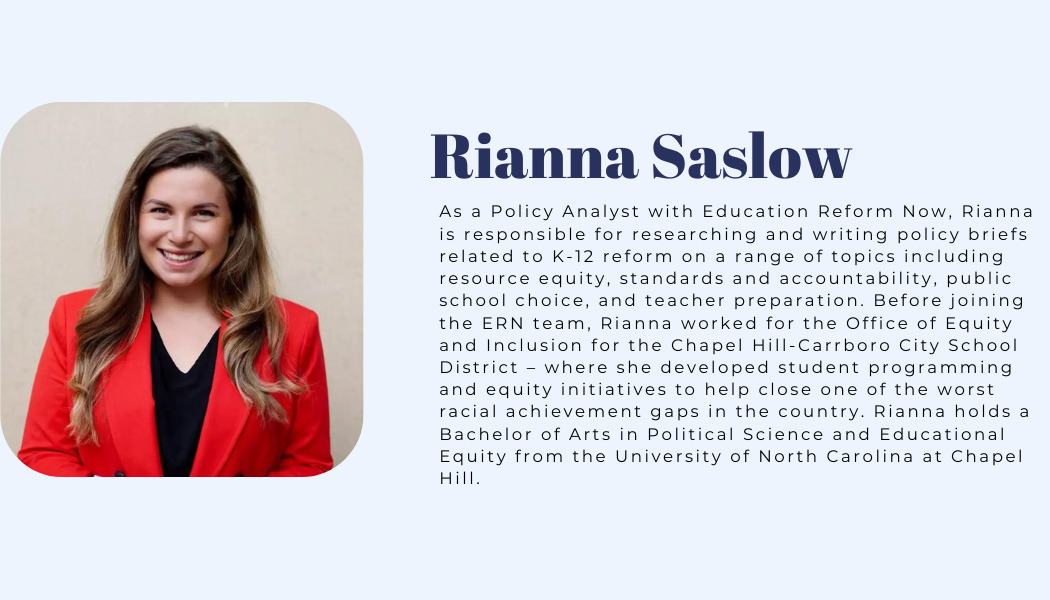
Five years ago, a groundbreaking collaboration between San Antonio’s industry and education leaders sought to develop homegrown talent for lucrative, high-demand careers. In 2019, this dynamic partnership led to the creation of the Centers for Applied Science and Technology, commonly known as CAST Schools. Now serving over 2,000 students across six schools and four districts, CAST offers students access to a diverse array of career pathways, ranging from biomedical research to cybersecurity to teaching. CAST’s unique approach empowers students to be catalysts in both charting their own educational and professional journeys and driving positive change within their schools and communities.
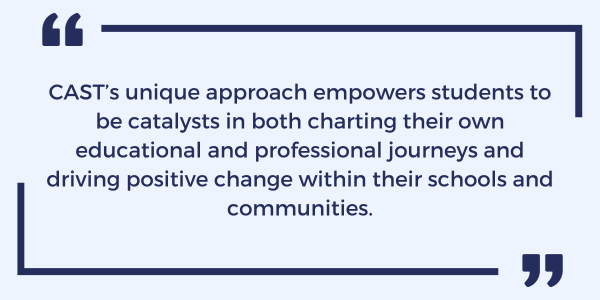
Students can access 15 different career pathways through CAST’s five high schools (Tech, STEM, Teach, Med, and Lead), while CAST’s Advanced Learning Academy offers a similar project-based learning model to grades PreK-12. Three schools have graduated their first cohorts, while the other three opened more recently and continue to grow capacity. Four schools took advantage of Texas’s SB1882 partnership legislation, which encourages schools to partner with third-party organizations (such as public charter schools, universities, or non-profits) to access greater levels of autonomy and, under certain conditions, secure additional funding or avoid state takeover.
Student Choice, Agency, and Empowerment
CAST students participate in projects designed by industry partners and have extensive access to mentorships, internships, and job-shadowing opportunities. Each school is also equipped with partnership coordinators, who help students develop resumes, LinkedIn profiles, and interview skills while connecting them to professional opportunities. This student-centered advising approach is devised so that each student graduates with a network of mentors who can provide additional professional opportunities and guide them through their college and career experiences.
CAST aims to cultivate a “purpose-driven approach,” whereby students have agency in directing their own learning journeys. This mission is precisely what makes the CAST network so unique. According to Executive Director Jeanne Russell, “there are a lot of conversations about schools of choice, but I don’t think there are enough conversations about the choices students make inside the schools and their ownership of their education.” With this in mind, CAST educators engage students in intentional conversations about their interests, passions, and aspirations–conversations which then inform how they proceed to support those students through internships, coursework, and mentorship.
Students also shape how their learning experiences are evaluated and discussed. Teachers engage students in conversations around grading and assessments, and they create opportunities for “student-driven” parent-teacher conferences, whereby students guide their caretakers through their strengths, weaknesses, and achievement data – effectively reimagining family engagement and data literacy.
While student agency proves vital to shaping an engaging school climate, it also prepares students to thrive beyond school walls. Alumni often report that CAST’s project-based learning taught them valuable skills in collaboration, communication, and time management – preparing them to thrive in college and the workforce. One former student, for example, obtained a phlebotomy certificate the summer after graduating from CAST Tech; while he didn’t go on to further pursue his high school pathway, he said that CAST taught him how to obtain marketable certificates, which have now positioned him to work a higher-paying job while saving money for college.
Students also utilize their agency to improve their schools writ large. Executive Director Russell emphasizes that CAST is all about “sharing power with students.” She says, “this is a real flip from how traditional education is done. It is our biggest form of quality control because if you really want to know what’s working in a school, ask the young people.”
CAST has a student advisory board that, according to reports from students and faculty, has real voice, real connections, and real power to implement ideas and solutions. For example, when students expressed interest but lack of opportunity to engage in service work, they connected with local community-based organizations to create a summer service camp where students from every CAST school could earn community service hours.
In another instance of student-driven programmatic changes, CAST Tech initially sought to offer a graphic design pathway. However, when students researched careers and opportunities in graphic design, they found that careers in user experience (UX) were more lucrative and in high-demand. This student research paved the way for further collaboration between teachers, administrators, and industry partners to establish one of the first UX public high school pathway programs in the country.
Students also note that they don’t need to serve on a formal board in order to influence their schools. Recent CAST graduate Alyssa Martinez reflects that “my voice didn’t come from me sitting on a panel… it came from the conversations I was able to have. It was easy for me to go to the principal to talk about a concern I had or to go to my partnership coordinator and request a guest speaker… It was the subtle things that were the reasons why I felt a part of the conversation and felt impactful to the school.”
In fact, at CAST Tech, student input is baked into the coursework. During their senior year, all students complete a legacy project, where they identify problems within their schools and develop solutions in teams. For example, Alyssa noticed an unmet need for mental health professionals in her school and proposed student “pals” to serve as bridges between their part-time SEL advisor and students seeking mental health services. While time and budget constraints did not allow for the immediate implementation of her idea, her presentation sparked interest among underclassmen who intend on moving the project forward.
Demographics
Located in the largest American city with a Hispanic majority, CAST’s student body is 80% Hispanic. While racial demographics in CAST schools within San Antonio ISD are largely reflective of the surrounding district, CAST schools have disproportionately lower enrollment among English Learners and economically disadvantaged students; even so, 50-68% of CAST students are economically disadvantaged. Most CAST schools serve students with disabilities at rates close to those for the district, with the exception of CAST Med.
*Graphs depict the three CAST schools located in San Antonio Independent School District (SAISD)
In San Antonio ISD, the Advanced Leadership Academy and CAST Tech were initially part of a strategy to re-engage families who had previously opted out of district schools. However, because these schools now serve a more affluent population than the district at large, CAST Schools and the district are collaborating to increase representation of economically disadvantaged students. These efforts are particularly pronounced at the Advanced Learning Academy, which has the smallest proportion of economically disadvantaged students, in part due to its initial marketing as a gifted and talented school.
CAST has opted into a lottery system for student admissions, with guardrails to ensure basic thresholds for representation; they do not have admissions criteria, nor do they track, sift, or sort students. However, cultivating diverse and inclusive spaces takes more than just avoiding exclusive practices; it requires a highly intentional approach to admissions, enrollment, and school climate writ large. Partner districts also play a critical role in building access and awareness of schools of choice.
Results
Student agency and industry partnerships may be exciting on paper, but do they actually work? The results are clear. Proficiency rates in all three CAST Schools in San Antonio School ISD vastly outperform district averages (see charts). There are also stark differences in chronic absenteeism, as more than six times as many students in San Antonio ISD are chronically absent as compared to CAST Tech.
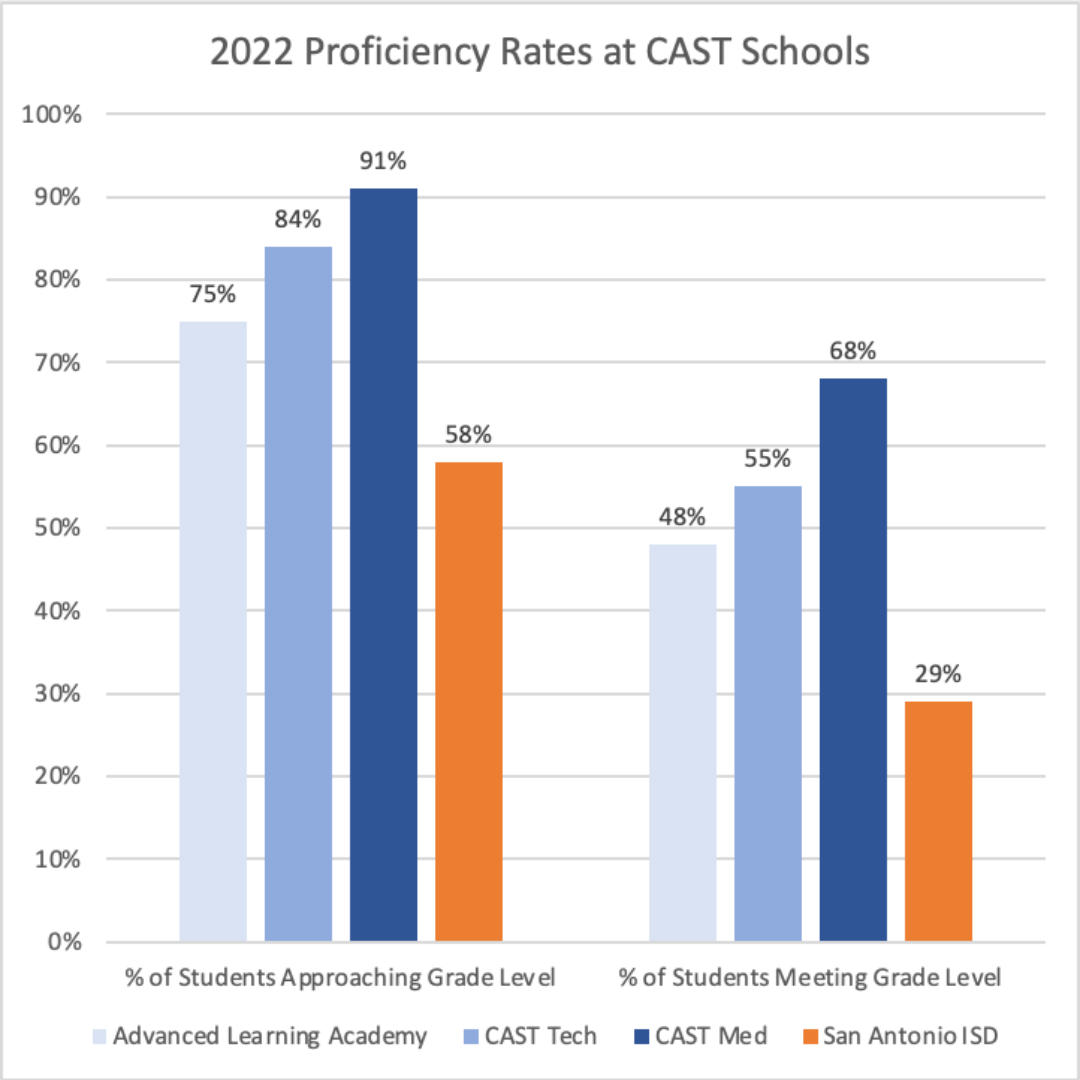

*Graphs depict the three CAST schools located in San Antonio Independent School District (SAISD)
**Proficiency rates represent data from Texas’s annual STAAR summative assessment across all subjects and grade levels
Although economically disadvantaged students are underrepresented in CAST schools, those who are enrolled have significantly better academic outcomes than their economically disadvantaged peers in traditional district schools (see chart). In fact, more than twice as many economically disadvantaged students at CAST Med were meeting grade-level expectations on the STAAR exam as compared to San Antonio ISD. Economically disadvantaged students at other CAST schools also met grade level expectations at higher rates than the district schools.
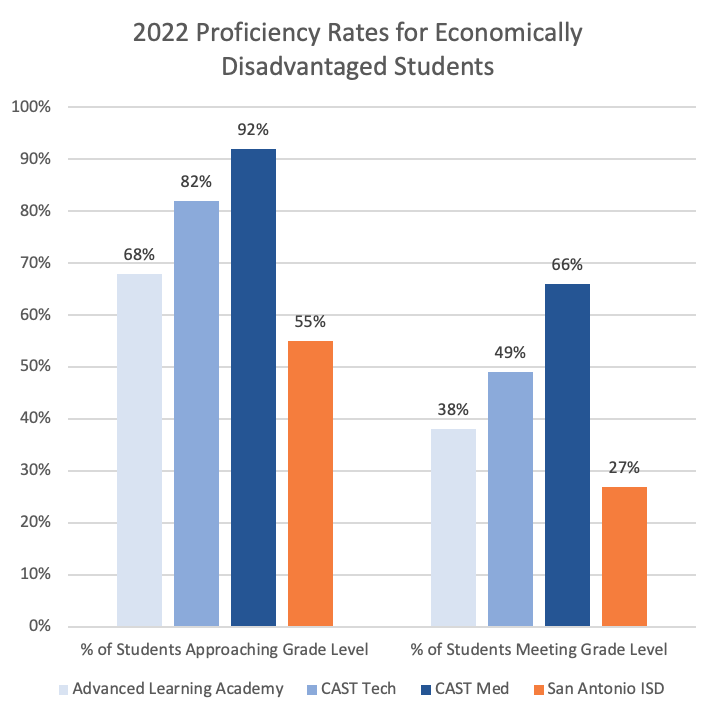
With such remarkable proficiency rates, it’s no surprise that CAST graduates are well prepared for college and the workforce. Ninety four percent of 2021 CAST seniors were college, career, or military ready – compared to just 75% of the school district they were in. Furthermore, 83% of Advanced Learning Academy graduates and 80% of CAST Tech graduates from the 2022 cohort enrolled in college within the first year of graduating. An impressive ninety-two percent of the 2023 graduating cohorts plan to enroll this year.

Conclusion
CAST has some room for improvement, especially as they work with local school districts to diversify enrollment to better fulfill their core mission of fostering economic mobility for the San Antonio community. Nonetheless, students across every demographic who are enrolled achieve academic proficiency, earn college credit, and gain work-based learning experiences at significantly higher rates than their peers at traditional district schools.
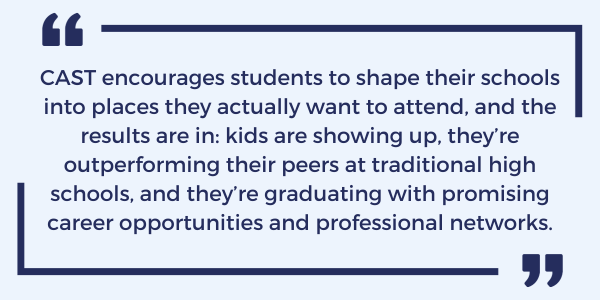
As schools seek to recover from pandemic-era learning, students across the country are disengaged now more than ever. Sixteen million students – or about 33% of students nationwide – were chronically absent last year, and many students don’t feel a sense of purpose or accomplishment when they do come to school. CAST encourages students to shape their schools into places they actually want to attend, and the results are in: kids are showing up, they’re outperforming their peers at traditional high schools, and they’re graduating with promising career opportunities and professional networks.
————-
To learn more about innovation school policies and their emergence on a national scale, check out this article by Alyssa Morton, CEO of empower schools.